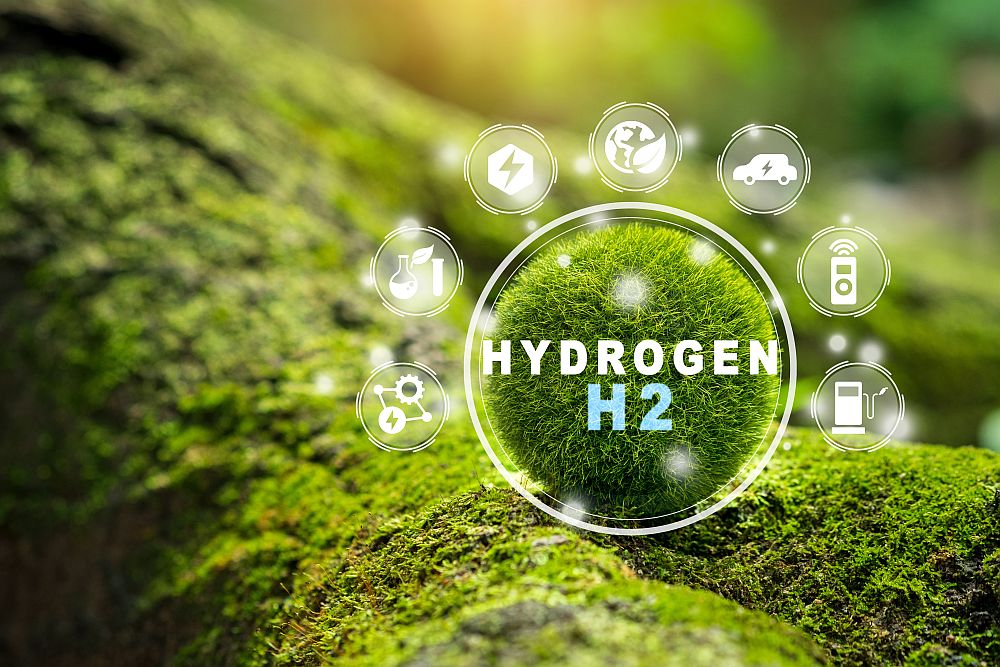
[Image above] An artistic illustration of how electricity can strengthen the sand along ocean coastlines. The inset shows a microscopy image of a “natural cement” (in blue) formed among grains of sand. Credit: Northwestern University
I’m a resident of Delaware, on the east coast of the United States. Delaware is 96 miles long, no more than 35 miles wide, and has 381 miles of coastline. These features mean Delaware ranks in the top 10 states for its coastline-to-area ratio. It is unsurprising, then, that Delaware has a keen interest in preventing coastal erosion.
Coastal erosion is a natural process that occurs when strong wave action, sea level rise, and coastal flooding wear down or carry away rocks, soils, and/or sands along the coast. However, the rise in frequency and intensity of extreme weather events is causing costs to erode faster than before, requiring immediate action.
Delaware has a significant beach nourishment and preservation program. However, beach replenishment is expensive, and who should be paying for it is a controversial proposition. So, the prospect of stabilizing beaches to keep them from eroding in the first place is intriguing to me (and potentially to many other residents of coastal regions).
Traditional beach stabilization methods such as seawalls and concrete bulkheads cannot be easily reversed and can cause environmental issues of their own, such as increased erosion and habitat destruction. They need to be replaced every few years as well. Natural solutions such as coral reefs, saltwater marshes, and mangrove stands have much better long-term stability, but cultivating these solutions takes time.
Recently, researchers at Northwestern University demonstrated an approach that could “spark” immediate action (pun intended) without detrimental environmental effects. Their method, which involves running an electric current through beach sand, builds on a long history of using electrical stimulation to stabilize soil.
Electrically induced soil stabilization
In the mid-1800s, scientists posited the idea of an electric “double layer,” which consists of two parallel layers of opposite electrical charge that exist at the interface between a solid and a liquid. In the case of wet soil, the water layer is positively charged and the soil layer is negatively charged.
In the 1930s, researchers tried to make use of this charge difference by applying an electric field to wet soil in hopes of driving the water out. By the 1960s, the emerging field of electro-osmotic stabilization was being used to stabilize soils in large-scale civil engineering projects, such as dams.
Simply driving the water out of the soil can lead to shrinking and crack formation due to the extensive drying. But the applied electric field can also induce physicochemical changes in the soil. Along with electro-osmotic stabilization, then, researchers became interested in electrochemical stabilization, which aims to induce microstructural changes in the soil through chemical reactions.
One of the biggest benefits of electrically induced soil stabilization is its ability to work on clay soils. Clay is a significant component in soils globally. It is commonly found near water and in coastal areas, which are vulnerable to flooding. This type of soil is also prone to landslides. Landslides kill more than 4,000 people every year. That number is expected to increase as torrential rains increase in frequency due to climate change. So, a reliable method to stabilize clay soils is urgently needed.
Biocement produced by bacterial metabolism is another technology with great promise for stabilizing various soil types. But this method requires the microbes to grow and thrive in the soil, which doesn’t work well in clay. So, electrically induced soil stimulation can be a good choice in these scenarios.
Mineralization on the beach
In the recent open-access article by the Northwestern researchers, they aimed to use electrochemical stabilization to induce mineralization of beach sands. They ran an electric current through sand saturated by seawater, and it resulted in the near-instantaneous precipitation of calcium carbonate, magnesium hydroxide, and hydromagnesite between the sand grains. These minerals improved the mechanical and hydraulic properties of the sand, hardening it against the effects of erosion and wave action.
Notably, if shorelines conditions change, the hardening process is reversible. As senior author Alessandro Rotta Loria, the Louis Berger associate professor of civil and environmental engineering, explains in a Northwestern press release, “The minerals form because we are locally raising the pH of the seawater around cathodic interfaces. If you switch the anode with the cathode, then localized reductions in pH are involved, which dissolve the previously precipitated minerals.”
The open-access paper, published in Communications Earth & Environment, is “Electrodeposition of calcareous cement from seawater in marine silica sands” (DOI: 10.1038/s43247-024-01604-3).
Future applications of electrically induced mineralization
Scientists are already looking at ways to use electrically induced mineralization in a range of processes. For example, mine tailings can be converted to dolomite, an anhydrous carbonate mineral, using electrical stimulation. Dolomite can be used to replace Portland cement in concrete. Thus, this process helps clean up mine tailings as well as reduces the carbon intensity of concrete production.
There’s been lots of interest in dolomite recently, which as a geologist I find fascinating. Dolomite was a mystery to geologists because for almost 200 years since its identification, scientists were unable to produce significant quantities of it in the lab. That mystery was recently solved, paving the way for wider applications of this mineral.
In time, it may even be possible to remediate soil contaminated with per- and polyfluoroalkyl substances, the so-called forever chemicals. I remain hopeful that human ingenuity can overcome many of the problems we seem so good at creating.
Further reading
A. Rzhanitzin, “Electrochemical stabilization of clayey ground.” Translated from Russian by V. P. Sokoloff, U. S. Geological Survey, 1947.
K. Lee and J. Q. Shang, “Electrochemical stabilization of offshore and onshore soils: A review.” Presented at the Twenty-fourth International Ocean and Polar Engineering Conference, Busan, Korea, June 2014.
P. Karpoff, “Stabilization of fine-grained soils by electro-osmotic and electrochemical methods.” Presented at the New Horizons in Construction Materials, International Symposium, Lehigh University, Bethlehem, Pennsylvania, Nov. 1–3, 1976.
U.S. Army Corps of Engineers Waterways Experiment Station, “Electrical stabilization of fine-grained soil,” October 1961.
Author
Becky Stewart
CTT Categories
- Environment


